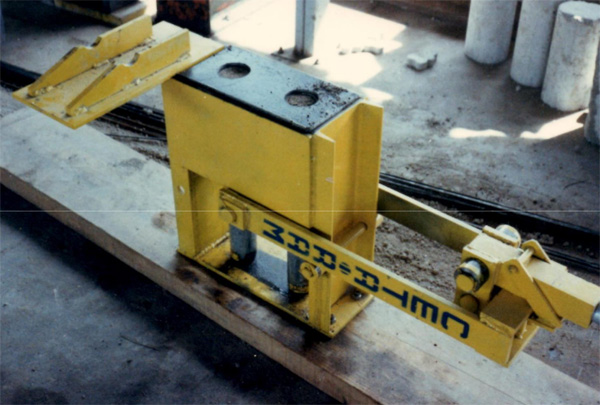
“by Roberto Lou Ma, Civil Engineer, Centro de Experimentación enTecnología Apropiada, Guatemala
The CETA-RAM is a manually operated block press, developed by the author just after the February 1976 Guatemalan Earthquake, specifically for the production of hollow soil-cement building blocks. The hollow blocks are intended for use in reinforced masonry for low cost earthquake resistant housing.The CETA-RAM is a modified version of the well known CINVA-RAM.The name CETA-RAM honors the Centro Experimental de Tecnología Apropiada (CETA), where it was developed, and the Chilean engineer Raúl Ramírez, creator of the CINVA-RAM.
The CETA-RAM is a compact and lightweight machine, mechanically simple, low in cost, and easily operated and maintained. Nevertheless, it is capable of molding at high pressure, dense and neatly finished blocks ofhigh structural quality, at the rate of 300 to 500 units per eight hour shift,when operated by two persons. Built entirely of steel, it is composed of three main assemblies (see drawings): – MOULD (1) with COVER PLATE (2)- PISTON (3)- YOKE (4) and LEVER DEVICE (5).
The dimensions of the CETA-RAM block are 32.3 x 15.7 x 11.5 cm. Two 6cm diameter holes run through its full thickness. The holes simplify the placement of vertical reinforcement in earthquake resistant wall constructions: the steel reinforcing rods running through the holes in the laid blocks, at the required spacing, are set in cement mortar or grout. The length of three blocks, included the respective joints, add exactly one meter. This comes out to be convenient in the planning and execution of low cost housing projects, as it allows a modular coordination on the basis of 50 and 100 centimeters, in both architectural and structural aspects. Twenty four blocks lay up one square meter of wall.
The CETA-RAM design has already been fully field proven. To date, CETA has built more than 50 units, used in various rural habitational projects throughout the country and abroad. Some of these machines have produced more than 60,000 blocks apiece, without operational problems and without undue wear. It would appear that with proper care and maintenance, the life span of CETA-RAM, expressed in terms of production, could conservatively be estimated at 100,000 blocks.”
Free download of CETA-RAM plans in metric and English available at Biorealis.com
Free download of complete plans in Spanish
Related:
Small-Scale Manufacture of Stabilized Soil Blocks
Soil Block Presses

I want to purchase 1pc of ceta ram were can I get it.
Thanks,
KANJARA
I am really happy to have found this press produced in Guatemala, I am looking for a CEB press for a social project in El Salvador and this is my perfect match. Do you know if it is still being built and sold? Can you give me any contact? Would be amazing, thanks!
I believe CEB construction is still popular in Latin America. Not sure what earth block presses they’re using. You’ll have to do your own local research.
Thanks! I´ll keep searching and will let you know if I find something interesting
Quick calculation for a small house measuring 6m square by 2.5m high. (Roughly 19.5′ x 19.5′ x 8′ high.) Not deducting for doors or windows for simplicity. That’s 60m2 total wall area x 24 blocks/m2 = 1,440 blocks total per house. Let’s say 1,300 blocks after deducting for windows and doors.
The CETA-RAM can make 100,000 blocks before wearing out. That’s about 77 small houses. Pretty impressive. That means you could build a larger house for yourself, several smaller buildings around your homestead and then sell it to a housing group that could go on to make another 70 houses or so for poor people.
I just popped out my tape measure in curiosity. One-third of a meter is about 33cm or 13″. That’s a little bigger than most CEBs, but still quite manageable by most workers in my opinion. So it’s not a ‘monster’ block. Just a little bigger and more efficient.
Good post Owen. I really like the free plans. I wonder how these types of block would work as a retaining wall against a hill? Any ideas or is this just too much for this type of material?
Retaining walls are totally exposed to the elements — rain, snow, freeze/thaw cycles, soil pressure. So CEBs would not be the best choice. My ebook explains how to build earthbag retaining walls that would be much stronger and more durable.
Awesome, like Legos :)
My ears perked up when I heard lighter, faster, easier. I’d love to see their soil and CEB blocks firsthand. Are they still building this way decades later? Maybe someone with spare time could send me an update on what’s happening there now.
This press makes larger blocks than the Cinva ram to make better use of lightweight volcanic soil. A Cinva ram seems best for typical heavy soils unless you have lightweight additives. Refer to yesterday’s blog post about using agricultural wastes for ideas.